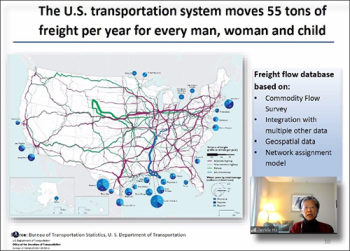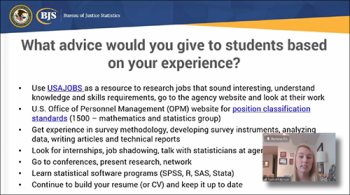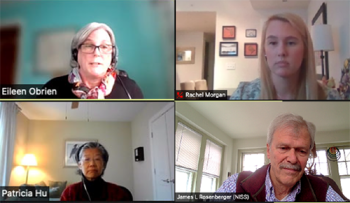


“When you work for the government, you’re not just working for a job, you are working for a mission.”
Eileen O’Brien (NASS)
We had an outstanding lineup of speakers during this Government Career Fair which took place on Wednesday, December 8, 2021, from 12-1:30 pm ET. Statisticians in governmental institutions have an important role to play when it comes to the data they collect, as well as the importance of the research they engage in. The research that comes from this data becomes very influential in the choices that are made in government and is the principal foundation for informing policy issues that impact all aspects of society in the United States.
This session gave us a better sense of what it’s like to work as a statistician in a governmental agency and provides valuable input about the kinds of opportunities there are for data scientists in the federal government. More importantly, this webinar better informs us on how to prepare yourself for obtaining a governmental position and the types of skills necessary to perform statistical research once you get there.
For this Government Career Fair, NISS brought together speakers who have extensive knowledge and experience in working for the federal government. These speakers included Patricia S. Hu (Bureau of Transportation Statistics), Rachel E. Morgan (Bureau of Justice Statistics), and was moderated by Eileen O’Brien (National Agricultural Statistics Service (NASS)). The original speakers list during this session included Jeffrey Gonzalez with the USDA Economic Research Service, however due to last minute changes his presentation will be postponed until the next Governmental Career Fair in Spring 2022.
Our speakers gave great resources to prospective employees and gave us a better understanding of the kinds of projects statisticians in a federal agency work on. Each presenter gave a 15-20 minute overview of their experiences, and shared information about their agencies and helpful tips to getting through the application process. This webinar also allowed for Q&A throughout the session and the speakers continued to answer questions after their presentations.
Prior to introducing the first speaker Patricia S. Hu, Eileen presented us with a few remarks from her perspective:
“Your work as a federal statistician isn’t just a job, you’re really representing a mission so you’re going to be involved over a career in being much more visible in representing your organization in professional capacities on Boards, speaking for a mission or a program or project, and you’ll get invited to do lots of professional activities because of that experience and access and knowledge.”
Eileen O’Brien (NASS)
Eileen shared how she began as a statistician working on data collection, data editing and analysis, met with actual producers of the data, and built sampling frames from the bottom up. In government, she mentions that there is a range of different types of people you work with including: leaders in industry, governmental officials at state and local level to ensure that the data that is collected is reliable and verifiable. While there was a different hiring scheme in the past, sometimes employers in the federal government might send you off to graduate school for specific skills. Other times, some agencies hire graduate students or post docs directly from universities and put them into headquarter offices. The transition from academia to a governmental profession in general requires patience and some advice on this will be helpful along the way. If you do work end up working in the government, it is also not uncommon to take on a different role every 3-5 years.
“We are very present and our work is highly regarded. While working in government, you will make connections with people early in your career that you will know decades later. It’s really a great community.”
Eileen O’Brien (NASS)
The United States has a decentralized federal statistical system which is unique compared to most countries. There are 13 principle statistical agencies, and if you have a technical expertise, there is a position out there for you. There is a considerable amount that work with modeling and a range of data science. There are prospects all the time on “USAJobs” which usually offers both near term and general opportunities. While there are other hiring sources online, it’s more beneficial to see what the federal agency’s website has as resources for opportunities directly. These can include fellowship programs that may not be present on third party websites.
Patricia (Pat) S. Hu, the current Director of the U.S. Department of Transportation’s Bureau of Transportation Statistics (BTS), shared multiple fascinating projects with us during this webinar that their statisticians worked on in her department, including “COVID-19 Impacts on Passenger Travel”. As BTS Director, she focuses on enhancing the quality, timeliness, accessibility, and availability of transportation statistics to inform transportation decisions. She is also the new chair for the ASA, Transportation Statistics Interest Group starting January 2022.
Pat highlights that in this line of work, you will use multiple data from different sources. Collaboration with other agencies at the state and local levels and stakeholders is an essential part of the work. All of our speakers echoed on this and find that it’s one of the components that is necessary to bring the research forward and also brings out the quality of the research itself. The Evidence Act of 2018 was created in order to ensure that we produce credible statistics, and the collaborations along the way make this even more possible.
In some of the collaborative projects with inter-gov agency working groups, Pat explains that:
“The system relies on data to run. It becomes the life blood of future transport.”
Patricia S. Hu (Bureau of Transportation Statistics)
Her main advice for obtaining a position in a federal agency is to keep learning. Agencies will be looking for a specific subject matter of expertise in their positions. Some of the skillset requirement that agencies will look for in a statistical position are whether you can perform estimates or analyze the data spatially, skills in modeling. There will be a capacity requirement of the skills their staff need to have. There are also fellowship programs on agencies websites to bring in new blood such as recent graduates. The government learns about new skill sets that can be used through these programs. It’s important to check each agency’s website for opportunities like fellowships among other types. BTS recently tackled the President’s Executive Order on implementing equity based on need, which is a government-wide initiative. There is also an ongoing climate initiative that many agencies have been mandated to focus on – so look out for opportunities in these areas!
Rachel E. Morgan from the Victimization Statistics Unit at the Bureau of Justice Statistics (BJS), provides insight on being a statistician both behind a desk and in the field! In her line of work statisticians collect, analyze, publish, and disseminates information on crime, criminal offenders, victims of crime, and the operation of the justice system at all levels of government. Employees will be sent out into the field for interviews to collect this kind of data needed for the research on these topics, which varies in all kinds of environments ranging from residents to prisons.
The advice Rachel shares with us is to always try to be present and to meet people in this field directly. Even by reaching out on initiatives or ongoing projects to people who are taking part in the work, asking questions, join in networking events if you can, and going to government job fairs. Your ability to network will get you far and helps to get you to where you want to go.
With the session’s lively Q&A, our viewers actively participation and many great questions were answered.
We thank our speakers for putting on incredible presentations and sharing abundant information with our audience. We look forward to the next Government Career Fair in Spring 2022!
Recording of the Session
Slides Used by the Speakers
Patricia S. Hu (Bureau of Transportation Statistics)
"Bureau of Transportation Statistics (BTS): Programs and Career Opportunities"
Rachel E. Morgan (Bureau of Justice Statistics)
